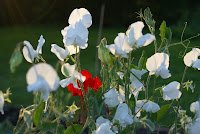
The winter has arrived with a bang here in Ireland with freezing temperatures and about two feet of snow in the garden, which has remained for the last week. I'm afraid that means it is good bye to the lettuce and probably most of the beautiful herbs out there for this year. Below are some pictures of the house and the conditions.Fingers crossed we'll get a thaw soon. Till then we are staying in with a warm cup of tea, green, white or with milk and sugar! Nearly forgot don't forget to leave out plenty of feed for your birds if you and they are suffering the cold like us. We have some store bought seed and a number of feeders. Water is important too, try and make sure they have some and make sure it isn't frozen solid! Also try not to leave too much feed or crumbs on the ground as it will, most likely attract vermin. My 5year old grandchild helped me feed the birds yesterday and together we made a bit of a mess, and this morning I went out to feed the birds only to find a shivering field mouse at the foot of the feeding table nibbling away. Field mice aren't so bad but if they come the bigger ones might not be too far behind so be careful. I include a couple of pics of the birds too. This Robin came in to the house when I left the door open while putting out the feed.
















